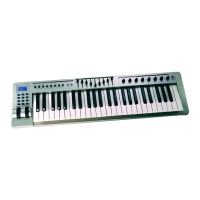7
Evolution MK-425C • MK-449C • MK-461C
English
Memory Dump
The dual press “MEMORY DUMP” buttons will send out a number of Sys Ex data packets that represent the 10 memories you have set up in your
MK-449C/461C (MK-225C:
Press “DATA LSB” and “RECALL” simultaneously to send out memory dump). This is useful for storing or backing up the contents of your memory
presets externally.
You can record the complete memory dump in to a standard sequencer. To recall the memory dump back, play the MIDI track containing the
recorded memory dump to the keyboard, making sure that the MK-425C/449C/461C’s drivers are selected as output for that particular track.
The current controller assignments are not affected by a memory dump, or a memory send to the keyboard. Once a memory dump has been sent
to the keyboard, you will need to recall a preset to access the new memory settings.
Assigning Device ID
The dual press “DEVICE ID” buttons will allow you to assign a Device ID to the MK-449C/461C (MK-225C: Press “PROGRAM and DATA MSB”). The
default Device ID is 127, which means when a memory dump is performed, that dump can be received by the same keyboard model, regardless
of the Device ID setting.
If a device ID is assigned to any number other than 127, the memory dump performed will be specific to MK-425C/449C/461C with the same device
ID. If the device ID of a MK-425C/449C/461C differs from the one recorded with the memory dump, the data will be ignored.
The device ID is a handy way of differentiating between multiple keyboards. Otherwise, we recommend you keep the device ID setting as 127.
When you press the Device ID buttons, you will see the small 2-digit display on LCD display ‘id’. The 3-digit display represents the assigned Device
ID. You can enter a new device ID using the numeric keypad, or the ‘+’ and ‘-’ buttons.
For more information on SysEx messages and device ID, please go to page 8.
Resetting To The Factory Default Setting
You can reset the MK-425C/449C/461C back to the factory defaults on power-up by holding down the +/- buttons.
Note: Restoring the Factory presets will erase all setups stored to memory.
MIDI Messages Explained
Program & Bank Changes Explained
The original GM MIDI specification catered for only 128 voices, numbered from 0-127. It is possible to access a different voice by sending a program
change.
In order to expand on the GM set of voices, Bank changes were devised. Each bank contains 128 patches, that can be accessed using a program
change. There are 16,384 banks available, accessible by sending a 14-bit Bank change message. The first 7 bits of this message are sent in a single
byte known as the Bank LSB. The last 7 bits are specified by another byte known as the Bank MSB. The BANK LSB is the most commonly used. This
allows for 128 bank changes, and often there is no need to send a Bank MSB.
You will find almost all MIDI devices respond to the program change, but some that do not conform to the GM set of voices use the program change
message for other purposes. Many VST instruments have adopted this approach, allowing you to use a program change to change the instrument
patch. The FM7 by Native Instruments is a good example of this.
Bank changes are more rarely used, although they do exist. Bank changes are useful in manufacturer’s extensions to the MIDI specification, such
as Roland’s GS specification and Yamaha’s XG specification. Both of these require you to specify a Bank change, in order to access the extra voices
and effects that these specifications provide.
Sending Program, Bank LSB and Bank MSB data is made simple using the Mk-425C/449C/461C. Simply press the PROGRAM, DATA LSB or DATA MSB
button and enter the program or bank change you wish to send.
3

